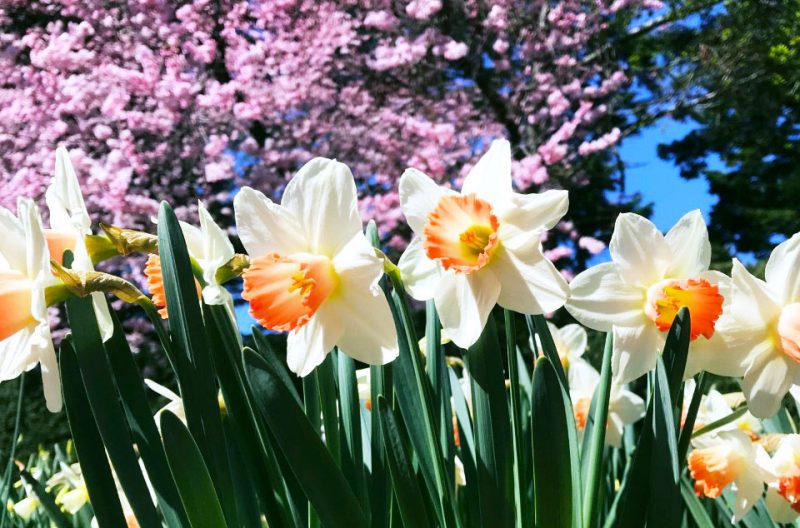Backyard Botanizing
Kristine Paulus is the Plant Records Manager at The New York Botanical Garden.

Narcissus ‘Pink Charm’ blooming in front of Prunus ‘Accolade’ along Rosen Seasonal Walk
Citizen science—also known as community science or public participation in scientific research—is the use of scientifically literate people to collect data, generate results, and generally conduct science. One of The New York Botanical Garden’s many citizen science projects is the Phenology Program. Working with the USA National Phenology Network (USANPN), NYBG engages volunteers in collecting important scientific data on different species of plants growing at NYBG. Trained by NYBG staff, citizen scientists observe and record the seasonal biological processes, such as when leaves, flowers, and fruits appear—a branch of science known as phenology.
Phenology is the study of the timing of life-cycle events in plants and animals, their recurrence, and their relationship to the environment. The word comes from the Greek root word phaino, which means to show or appear. It is nature’s calendar—when cherry trees bloom, when a robin builds its nest, and when leaves turn color in the fall.
NYBG’s phenology volunteers are assigned a group of plants to regularly observe in a specific area of the Botanical Garden, such as the Native Plant Garden or the Thain Family Forest. Phenology volunteers enter their observations in the USANPN mobile app called Nature’s Notebook. These data can then be used by anyone for research, land-management, or decision-making. NYBG staff use the data to analyze the collections, and the information helps scientists who are studying the impacts of climate change. Citizen science projects have the ability to collect large amounts of data because they consist of large volunteer groups, but they usually require technical or scientific staff to analyze data and decipher patterns.
The observations collected by NYBG volunteers are also added to the Garden’s living collections database and are viewable in the online catalog, Garden Navigator. Users can see when plants have been observed blooming or search for blooms by date. NYBG’s phenology volunteers cannot currently record regular observations because the Garden grounds are temporarily closed to help reduce the spread of COVID-19, but anyone can observe in a backyard or perhaps even from a window if they are lucky enough to have street trees or other plants within view. Please note, however, that this does not qualify for NYBG volunteer hours.
Step 1: Sign Up
The first step is to create an account by joining Nature’s Notebook.
Step 2: Create Site
Choose your site. This is where you plan to observe. It should be convenient and easily accessible, such as your backyard or a public park. Name your site and enter the address. Then click CREATE SITE at the bottom left corner of the screen. If observing in a public space, you must adhere to physical distancing (also known as social distancing) restrictions and maintain a distance of six feet between yourself and others.
Step 3: Select Plants
Identify plants in the area where you’ll be observing and enter the plant name in the box or choose one from the list. Plants entered must be on USANPN’s list of approved species, which are mostly native plants.
Step 4: Download the Nature’s Notebook app and start Observing
Most observers enter their data directly into the app while they are out in field. You can also print datasheets and enter observations later. Each time you observe a plant, enter “Yes” or “No” for the phenophase you observe. Phenophases include breaking leaf buds, immature flowers (buds), open flowers, ripe fruit, fall color and leaf drop. Be sure to save and sync your data so they are uploaded to the USANPN database.
The USA National Phenology Network offers numerous videos and tutorials on its website to get you started. Here are a few of the resources:
If you, like us, are getting a little stir-crazy and are itching to go outdoors, collecting phenology information is a great way to get outside, study plants, and record important data that will be used by scientists. Spring is quickly unfolding around us, and 2020 looks to be one of the earliest on record. Just remember to maintain a six-foot distance from other people, wash your hands, and do not touch your face.
SUBSCRIBE
Enter your email address to subscribe to this blog and receive updates on new posts.











